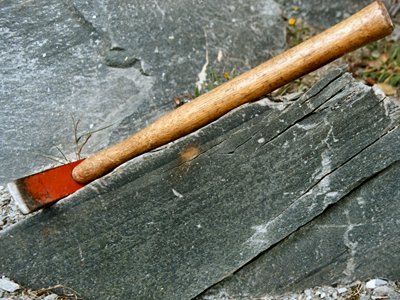Earth Science Conservation Review
| Prehen Quarry - Dalradian | Londonderry |
| Site Type: | Quarry (disused) |
| Site Status: | ESCR |
| Grid Reference: | C423147 |
| Google maps: | 54.97847,-7.33934 |
| Rocks | |
|---|---|
| Rock Age: | Precambrian (Dalradian) |
| Rock Name: | Ballykelly Formation, Londonderry Formation, Southern Highlands Group |
| Rock Type: | Greywacke, Turbidite |
| Interest | |
| Other interest: | syncline |
Summary of site:
This abandoned, now flooded and overgrown quarry worked rocks thought to be part of the last formation of the Southern Highland Group of ancient Dalradian rocks, the Londonderry Formation. The dominant rock type is an altered greywacke, a kind of sandstone, slightly lime-rich, clearly bedded, with fine grained schists in the partings. The beds of greywacke are graded with coarse grits at the base of each bed fining to sandy textures near the top. This structure results from gravity settling of particles, heaviest first and provides clear evidence of the base and top of each bed indicating whether they are now the right way up or overturned. At Prehen the beds are the right way up.
Cleavage (fractures along mineral alignments) is evident in the rocks, cutting through the beds and its orientation provides clues to the history of large-scale, regional folding.
The rocks were originally deposited over 600 million years ago in an oceanic trough close to the South Pole where unstable sediments slipped from the flanks to settle in deep water. The trough continued to open along its axis and the giant continent of which it was a part began to fragment. A continent called Laurentia (including parts of what are now North America, Greenland, the north of Ireland and Scotland) separated as a plate of rock and began to drift northwards towards the equator where it collided with another plate around 470 million years ago. It was this collision, called the Grampian orogeny that buried and baked these rocks (regionally metamorphosed them) and created the regional folding that extends right across the north of Ireland into Scotland. The cleavages in Prehen Quarry were also a consequence of this collision. The degree of metamorphism, as indicated by the minerals formed during the process, was relatively light.
This locality is important because it preserves clear metamorphosed greywackes with evident graded bedding and cleavages that relate to the structural history, particularly of major regional folding affecting Ireland and Scotland. The quality of the original outcrop would justify the preservation and conservation of the north western face of the quarry but there is now a need to clear obscuring vegetation.
The quarry was extensively developed in the Second World War to provide aggregate for the many military installations around Londonderry.
Cleavage (fractures along mineral alignments) is evident in the rocks, cutting through the beds and its orientation provides clues to the history of large-scale, regional folding.
The rocks were originally deposited over 600 million years ago in an oceanic trough close to the South Pole where unstable sediments slipped from the flanks to settle in deep water. The trough continued to open along its axis and the giant continent of which it was a part began to fragment. A continent called Laurentia (including parts of what are now North America, Greenland, the north of Ireland and Scotland) separated as a plate of rock and began to drift northwards towards the equator where it collided with another plate around 470 million years ago. It was this collision, called the Grampian orogeny that buried and baked these rocks (regionally metamorphosed them) and created the regional folding that extends right across the north of Ireland into Scotland. The cleavages in Prehen Quarry were also a consequence of this collision. The degree of metamorphism, as indicated by the minerals formed during the process, was relatively light.
This locality is important because it preserves clear metamorphosed greywackes with evident graded bedding and cleavages that relate to the structural history, particularly of major regional folding affecting Ireland and Scotland. The quality of the original outcrop would justify the preservation and conservation of the north western face of the quarry but there is now a need to clear obscuring vegetation.
The quarry was extensively developed in the Second World War to provide aggregate for the many military installations around Londonderry.
| Enlander, I., Dempster, M. & Doughty, P., 2025. Prehen Quarry - Dalradian, County Londonderry, site summary. [In] Earth Science Conservation Review. https://www.habitas.org.uk/escr/summary.php?item=153. Accessed on 2025-04-03 |
| Previous Site | Next Site |

